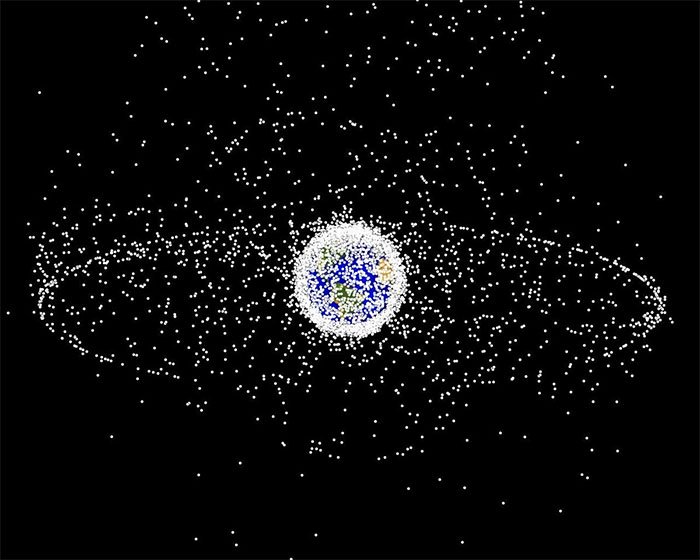19-year-old female student uses artificial intelligence to clean up garbage in the vast universe
To help astronauts be safer when working in space, college girls have found a way to clean up the debris in Earth's orbit with artificial intelligence.
After watching a sci-fi movie about NASA's spacecraft being destroyed by collision with debris and space debris in Earth's orbit, schoolgirl Amber Yang fell into a real nightmare. and the desire to find a way to help prevent disasters.

First-year schoolgirl Amber Yang has won many technological awards for research using artificial intelligence to clean up space junk.(Photo: CNN).
In fact, Earth's orbit is a place full of rubbish, mostly debris or even old, unused ships, launched from the Cold War and until now no one who acknowledges responsibility for them.
A theory, called Kessler , is the scenario that happens when the debris collides with one another to create a massive explosion and threaten directly to the International Space Station (ISS) in the low orbit of the planet. planet or even fall to the surface of the earth and cause 'artificial disasters'.

About 95% of the white dots in this image are cosmic junk, which is no longer used.This image simulates the observation position 35,785 km from Earth and from there we can see cosmic garbage in both low and high orbit.(Photo: NASA).
We can afford to actively and safely transport thousands of large and small space debris back to Earth, but this will take a lot of time and money to make no government move. care to make. Therefore, Amber Yang will play the role of rescuing the Earth by clearing space junk with AI.
Not only very loud but also very fast
From the surface of the planet a few hundred kilometers up, we will reach the low-level orbit of the Earth. There are not only astronauts working at the ISS, but also millions of small and large space debris. They vary in shape and size, but one thing they have in common is that they move 10 times faster than a bullet from a muzzle.

A close-up image shows NASA's Solar MAX probe, which has a large hole due to collision with space debris.(Photo: NASA).
At such a dizzying speed, a piece of material with a surface area of just 1 cm has the same damage as a hand grenade - meaning they are very dangerous and can not be prevented if unfortunately we lie on their way of attack.
Space missions when launching ships from Earth also carefully calculate the flight path of the ship, in order to avoid hitting obstacles. The European Aviation Authority once said that space junk is the third highest risk of a space mission failure.

The window glass on NASA's spacecraft cracked after being hit by space junk.The type of glass used to design a spacecraft can withstand enormous forces but is still affected if there is a collision in space.(Photo: NASA).
The United States Department of Defense has also set up a team that has the expertise to permanently monitor the cosmic waste, adjusting both the space missions that are in progress, and monitoring if there is an incident that will respond promptly. Timothy Payne, head of the group's expertise, said: 'We update data and report to NASA within 10 days so we can make a timely plan if something goes wrong.'
But 10 days is a modest time, Amber Yang said he has a more accurate prediction solution and the forecasting time can be extended to several weeks. This method is not a simple theory on paper, the female student has received many awards for her initiative.

An Earth research satellite (top edge of the image) was taken from space shuttle Challenger in 1984. This satellite carried a lot of scientific research equipment but was eventually abandoned in Earth's orbit. since 1990. (Image: NASA).
True 98% forecast for the future half a month
'I started studying astrophysics when I was 9 years old, and when I was in grade 11, I turned to practical problems , ' ' Yang told CNN correspondent. By taking survey data from both ground and space tracking radars, she created a predictive set called Kalman using complex algorithms.
In 2016, Yang started to apply artificial intelligence to his predictions and turn it into a real-world nervous system that can learn and make judgments based on his experience and data. From here, Yang's Kalman can easily determine which piece of trash will move quickly / slowly, with the rate of falling or collision.

Screenshot of Yang's software, showing predictions of the path of abandoned artificial satellites made by artificial intelligence.
To make the data more intuitive and easier to follow, Yang built his own computer software. In this software, she put many physical laws and changed them so that everything can happen by simulating themselves without people having to interfere too much.
'This is a whole new experience for me, I've never had to type in a lot of programming code before and the results are worth it when I just sit still and watch the computer run the simulator myself,' Yang said. Share and indicate that your system predicts 98% accuracy for 16 days of future data.

Small pieces of cosmic dust collide with the surface of the Hubble Space Telescope.(Photo: NASA).
'My system can predict further but there are many factors that will cause the results to be skewed if the simulator is run too far. Artificial intelligence is essentially self-learning and self-generating results, so I will load more data so that computers can learn more, thereby giving more accurate results, '' she said. know.
Tech start-up from sitting in a school chair
Amber Yang submits his project to numerous contests. At the end of 2019, she brought the product to CERN to attend the White House Border Science Conference and had an inspiring TEDx talk to share about the limits and potential of a female student participating in the research. scientific research.

Amber Yang at Intel Foundation Award for Young Scientists.(Photo: Intel).
Previously in 2017, she was in the final round of the Regeneron Science Talent Search and won the Intel Foundation Award for Young Scientists with a $ 50,000 scholarship. Yang then majored in Physics at Stanford University.
Here, the female student began to commercialize her research product.'I received a lot of offers from both government and private companies about opening my own company to develop my project. Businesses are very interested in my product because it basically does not take too much money to develop.
I have not yet set a price for my software but many companies have paid US $ 750,000 to US $ 1 million. Immediately, I will develop more for my project and then will find an investor to start a business. I hope my product will help a little bit for NASA astronauts and engineers , ' Yang said.

Yang said he will develop more features for his software and start his career from technology.(Photo: Orlando Sentinel).
Timothy Payne from the US Department of Defense said the agency has not yet applied artificial intelligence and neural networks to explore space junk, but said it would be reviewed and used in the future.'Up to now, we have not recorded any unfortunate incidents of collision with cosmic debris.
However, the future is unpredictable, so we will consider using this young girl's technology. I feel very happy because there are young people interested in this field and even have new ideas for it, ' he shared.
- He launched a tuberculosis test to clear the universe
- Japan fabricates garbage collection in space
- Why is the gender of artificial intelligence often female?
- Clear up garbage on the vast universe
- What is Artificial Intelligence? What is AI (artificial intelligence)?
- Clearing garbage on the universe
- Japan makes a net to clean garbage in space
- Artificial intelligence is also important to men and women
- Machine to clean up space
- Discovering that AI recruiting is important to men and women, Amazon is forced to turn it off
- People have mentioned AI since 65 years ago, what will happen in 2018?
- China wants to dominate global artificial intelligence
- IBM's artificial intelligence invented new perfumes
- The United States allows the use of artificial intelligence to diagnose diseases
 Van Allen's belt and evidence that the Apollo 11 mission to the Moon was myth
Van Allen's belt and evidence that the Apollo 11 mission to the Moon was myth The levels of civilization in the universe (Kardashev scale)
The levels of civilization in the universe (Kardashev scale) Today Mars, the sun and the Earth are aligned
Today Mars, the sun and the Earth are aligned The Amazon owner announced a secret plan to build a space base for thousands of people
The Amazon owner announced a secret plan to build a space base for thousands of people 'Strange smell' detected on cargo spacecraft to ISS
'Strange smell' detected on cargo spacecraft to ISS  After 4 years of being sent into space by Elon Musk, what is the fate of the $100,000 Tesla Roadster now?
After 4 years of being sent into space by Elon Musk, what is the fate of the $100,000 Tesla Roadster now?  The Shape of the Universe Isn't What You Think: From Ancient Round Sky to Modern Three-Dimensional Donut
The Shape of the Universe Isn't What You Think: From Ancient Round Sky to Modern Three-Dimensional Donut  How to get back to the spacecraft if the astronauts leave the cabin to work and accidentally drift away?
How to get back to the spacecraft if the astronauts leave the cabin to work and accidentally drift away?  Announcement of discovery of micro-asteroid population in the Solar System
Announcement of discovery of micro-asteroid population in the Solar System  Solving 'traffic jams' in space
Solving 'traffic jams' in space 